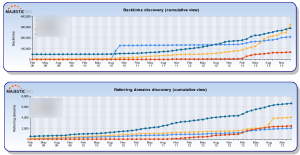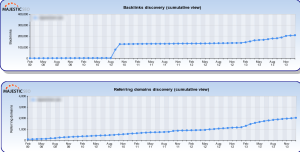SEO Measurement Mistakes, Part 4: Links

This is part 4 of a series examining mistakes with SEO metrics.
- In part 1 of this series, we discussed 5 huge mistakes regarding top-level SEO KPIs.
- In part 2, we looked at 10 common mistakes made when analyzing SEO metrics in Google Analytics.
- In part 3, we looked at 10 critical errors in analyzing and monitoring crawling and indexation metrics.
Today, we’ll do 10 of the most common mistakes in link metrics.
1. Ignoring Traffic
SEO practitioners commonly forget that links matter outside of SEO. But links can do more than give your site link juice. They can give you instant traffic. After all, traffic is what you’re doing SEO for, ain’t it? But yet SEOs still frequently ignore referral traffic from links.
Here’s a few reasons you need to keep an eye on it:
- It helps you better understand the benefits of your link-earning efforts.
- It helps you beat SEO-tunnel-vision regarding links and earned media. SEO-tunnel vision may cause you to ignore links that potentially lucrative in traffic that might be no-follow, repeat links from the same site, or otherwise less beneficial from a link-juice perspective.
- You’ll understand your audience and the places they hang out better.
- You’ll get useful insights for display advertising.
- It gives you insight on which links are most SEO-beneficial because links that generate traffic tend to help your rankings more. Think about it. Links that are powerful for SEO when they are on authoritative pages of authoritative sites that are relevant to your page and site. That highly correlates directly with traffic (high visibility pages on high traffic site being used by an audience more likely to be in your niche.)
- Some of that traffic converts. Always pay attention to traffic that converts.
Here’s an article I wrote on examining link traffic.
2. Not Tracking Growth in Authority
Of course, link juice matters too. But many SEOs don’t even track improvements over time to link juice.
You need to know if you are actually improving link equity, if its improving at the rate you need to meet your goals, and if you are seeing a return on your link-winning efforts.
3. Obsessing over “PageRank”
Toolbar PageRank – the little bar that looks like

– is a badly overused metric. Here’s some reasons why:
First, It’s not granular at all. PageRank only has 10 spots, and the difference between them can be huge. PageRank is based on a logarithmic formula, so while it’s not too hard to jump from a 0 to a 1, it’s really hard to jump from a 5 to a 6 – this would take most PR 5 sites well over a year.
Second, it’s rarely updated. If your PR 5 site jumped to a 6, it could take months for the bar to get updated for you to find out. And the updates are highly irregular. Here’s an article on the last update, which took place 10 months after the one before. Hard to say if it will be updated again, even.
Third, we don’t know what factors go into toolbar PageRank. Toolbar PageRank definitely does not fully guage authority or ranking power of a site. In fact, no one is certain it even takes into account all of the link equity and link trust metrics Google uses.
So do not use Toolbar PageRank metric as the sole indicator of your link equity, especially when looking to gauge performance and growth. Take a look at other data sources to monitor regular growth in link equity.
Estimates on number of links, root domains, and c-blocks can provide some insight. I like Majestic SEO for this data.
Metrics on estimated link equity that aggregate all that data into one metric can be super actionable. Hrefs and Moz (Open Site Explorer) do a solid job estimating link-equity of a page or site.
4. Not Benchmarking Your Data
Every link data tool and every niche I’ve ever encountered exhibits regular, quirky fluctuations in their reported link metrics. The only way to tell if you’ve truly moving one way or the other is to benchmark against several other sites in your niche and compare your relative movement to the aggregate.
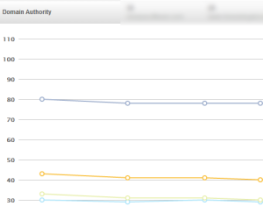
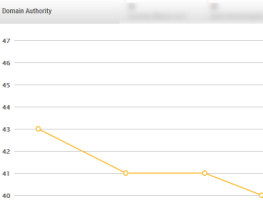
Benchmark at the keyword/page level too. You may think your page has a lot of links, but your competition for your target keywords may have more or better links.
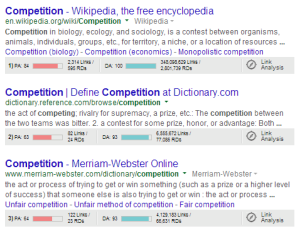
Check link competition in the SERPs
5. Micromanaging Link Profile Metrics
Look at the big picture when it comes to link metrics. Don’t don’t spend my time monitoring minute metrics of current individual links like: anchor text distribution, nofollow distribution, proportion of link .edu tlds, proportion of Pagerank 5+ links, proportion of link type X, Y, and Z, etc…
Now, I’ll check this stuff out at the beginning of a campaign to make sure the client’s profile is natural, nothing shady was going on, and there’s no penalty risk, but I simply don’t believe in having to regularly micromanage all the metrics that indicate a natural profile.
Why? Because these details are not actionable data if you’re winning links the way the search engines want you to. If you’re trying to win editorial links (article on editorial vs. acquired links here) like you should, you only have so much influence on the details and you’re risk-free anyways. That granular data might have helped indicate risk and reward for old-school link building tactics that were effective in the past, but it’s almost entirely irrelevant for running successful link-winning campaigns today.
The point of paying attention to link metrics is to manage your approach to winning links – not your link portfolio. If you find yourself needing to obsess over granular backlink details, you’re probably mismanaging your entire approach.
6. Not Examining Authority by Page
One detail most miss is how much link equity flows to the various pages. You can and should exercise a lot of control over what you do with the link equity that flows to your site via internal linking, architecture, and keyword targeting. Additionally, it’s very important to know understand which pages have the most link equity and why, so you can be better at getting link equity where you need it.

Know your top link-earning pages
Thus metrics on link equity per page can help inform countless decisions like:
- Where I should target easy keyword x and hard keyword z?
- Do I need to link more from page x?
- Should I internally link more to page y?
- Should I tweak the main menu?
- Should I upgrade site architecture?
- How to employ link winning methods that have worked before (like what link bait works;)
7. Not Examining Link Bait Effectiveness

source: bizactions.com
If you’re trying to win links in 2014, you’re probably creating content you hope people will share and link to. But many content creators and marketers fail to figure out what works and what doesn’t. Link baiting shouldn’t be like throwing spaghetti at the wall.
Pull out your data on backlinks and pay page and pay attention to links to your content and note things like:
- the author
- the topic
- the style
- the content format
- promotional tactics
- the time and cost involved in creating the content
Continuously study these elements in the content that got good links and social sharing and in the content that didn’t.
8. Not measuring outreach effectiveness
The same failure to measure is often found in outreach. You really want to know if you’re doing it right, and you always want to know how to do better. To that end, keep an eye on metrics like:
- time spent on outreach
- # of emails/contacts
- response rate on emails/contacts
- placement rate
- placement impact
If you put your outreach metrics together with some solid content metrics you can calculate weighted cost-per-link (I’d factor in traffic to the equation). Then you can get some deeper insight on what works best.
9. Not Looking into Other, Non-link Authority Metrics
Links are only one element of authority, and other signals continue to become more important to raw rankings power.
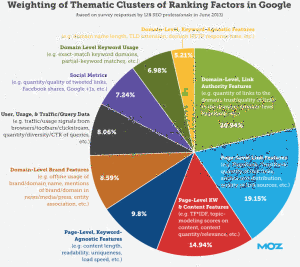
How much of what can be called authority isn’t actually link-related? Experts agree we’ve got several other quality and popularity signals being factored in. So if you’re ignoring indicators of popularity and trust like engagement metrics, brand mentions, and social share metrics, you’re not truly measuring SEO authority.
10. Not Tying Links to Other Key Metrics
Looking at links alone is limiting. But even if you have a solid holistic grasp of your page and domain authority, your actionable insights are yet limited if you don’t tie that to other important metrics. For example:
- Tie a page’s authority to keyword clicks and rankings to decide if a page needs an update in keyword optimization or more authority.
- Check your keyword/architecture strategy by comparing your most authoritative pages to your pages with he most organic traffic value.
- Check your indexation metrics to ensure that index bloat isn’t diluting your link equity.
- See if a link campaign is helping brand equity by looking for correlations in referral traffic, earned media impressions, branded organic traffic, and direct traffic.
The bottom line: if you’ve done the work to get the links, put the data together to make sure you’re making the most out of your efforts.
